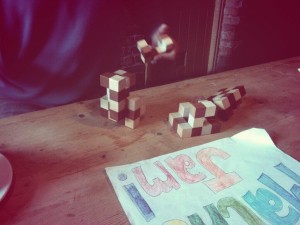 This month we had a few new faces, and plenty of regulars. We also had someone’s first MathsJam, and someone’s last (in the UK): Manchester regular Nicolette brought along her 6-week old baby Julia, who experienced her first recreational maths night in a pub, and by this time next month Nicolette will be back in her native New Zealand (obviously, setting up a new MathsJam there).
This month we had a few new faces, and plenty of regulars. We also had someone’s first MathsJam, and someone’s last (in the UK): Manchester regular Nicolette brought along her 6-week old baby Julia, who experienced her first recreational maths night in a pub, and by this time next month Nicolette will be back in her native New Zealand (obviously, setting up a new MathsJam there).
We covered a few nice puzzles, found on the blog Futility Closet:
- This puzzle about piles of rocks, from the Moscow Olympiad
- This triangle in a circle in a triangle, which took me back to a holiday I once went on where nobody else could see the easy solution
- This cube puzzle, which was discussed without me and I don’t even know if anyone got an answer, but it looks nice
We also played some good games, including Tantrix, which we all recommend heartily to anyone who’s looking to invest in maths games – it can be played as a multiplayer competitive tabletop game, but it also includes endless layers of puzzles, using different subsets of the pieces and trying to create closed loops. Plus, it’s good for making pretty patterns. Insider tip: Pocket Tantrix is half the price, and does exactly the same thing but is a bit smaller.
We also had a quick game of meta-noughts and crosses (listed on the tic-tac-toe Wikipedia page as ‘super tic-tac-toe’, and marketed as ‘Tic-tac-toe-ten’), inspired by some of the other MathsJams who were playing it. We realised halfway through we didn’t have a full grasp of the rules (if the board you’re required to go in next is full, where do you go?) but good fun was had by all.
Chris, who’s a survivor from the recently hiatused Northampton MathsJam (he was the organiser, but he moved to Manchester) came along and brought, among other things, a deck of cards for the game Skat. It’s a German game, which uses only the cards 7, 8, 9, 10, J, Q, K, A in each of the four suits. Firstly, props to whichever marketing genius realised you could sell people a special deck for this, rather than just using an existing deck and leaving some of the cards in the box. The game (as far as we could work out, using the rules from the Wikipedia page) is similar to bridge, in that there’s an auction and then cards are played in tricks, but the order in which cards beat each other is not the same as the number of points you get for that card, nor is either of these the natural ordering of the cards. There are several other ways in which it was confusing, but I think one hand was successfully played (at least one of the players had bridge experience, but apparently that didn’t help).
In order to have a less confusing card game experience, we moved on to the game of Mad Abel. Having been asked by an attendee ‘What’s the mathsiest card game you know?’, I was obliged to show everyone this game, which has previously been a favourite at Newcastle MathsJam. It’s fairly simple in that you have to take it in turns to lay cards from your hand, and the first person to place down all their cards wins. You must lay down one or more cards which sum to the same total as the top two cards on the pile of cards on the table, and the main mathematical twist in the game comes in the way you ‘add’ the cards together.
It’d be a great game to learn if you want to improve your finite group theory: the cards are thought of as group elements, where you ‘add’ the suit and rank separately, modulo four and thirteen respectively, to get the sum. Hearts is 0, spades is 1, diamonds is 2 and clubs is 3 (cue brilliant mnemonics, including my favourite ‘hearts is love’), but you only consider the remainder after division by four, and so if you add a diamond to a club you get a spade, and if you add a heart to a club you get a club. Then you add the ranks of the cards, where king is 13 (which equals zero) and then ace is one, two is two and so on up to queen is 12 (or -1), again considering only the remainder on division by 13.
Each turn is accompanied by a long pensive stare at your cards, repeatedly asking what the sum of the top two cards on the table is again to kill some time, and occasionally someone works out they can go (and everyone checks it’s right). If you can’t go (we noticed this was often more because you couldn’t figure out whether you had a valid move than that you didn’t have the cards) you have to pick up two cards. There’s a full explanation of the rules by its author Smarí McCarthy, which also goes into prime number variants.
That’s all for this month, but next month the students will be back, so we’ll lose our nice quietness and be back to a noisy pub – although this may bring fresh attendees and boost our numbers! Hope to see you then.
Katie can you tell me where there is a Mathsjam in New Zealand?